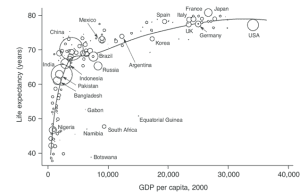TAG: GS 3: ECONOMY
THE CONTEXT: The Preston curve refers to a certain empirical relationship that is witnessed between life expectancy and per capita income in a country.
EXPLANATION:
Preston Curve: Linking Income and Life Expectancy
- The Preston curve is an empirical relationship that describes the association between a country’s per capita income and the life expectancy of its population.
- It was first proposed by American sociologist Samuel H. Preston in his 1975 paper “The changing relation between mortality and level of economic development”.
- The curve demonstrates that individuals living in richer countries generally have longer life spans compared to those in poorer countries.

Relationship Between Income and Life Expectancy
- The key insights from the Preston curve are:
- Positive Relationship:
- There is a positive correlation between a country’s per capita income and the life expectancy of its population.
- As a country’s income rises, its people tend to live longer on average.
- Diminishing Returns:
- The positive relationship between income and life expectancy is not linear.
- The curve flattens out at higher income levels, indicating diminishing returns – further increases in income lead to smaller gains in life expectancy.
- Upward Shift Over Time:
- The Preston curve has shifted upwards over the 20th century, meaning that life expectancy has increased independently of changes in income.
- Preston attributed this to factors like medical progress, education, public health services, and improved nutrition.
- Positive Relationship:
Criticisms and Limitations
- While the Preston curve is a well-established empirical relationship, it has faced some criticisms and limitations:
- Lack of Longitudinal Evidence:
- The curve is based on cross-country data, but some research suggests the relationship may not hold within individual countries over time.
- Per capita incomes have generally diverged across countries, while life expectancies have converged.
- Causality Concerns:
- The relationship between income and health is complex, and the direction of causality is debated.
- It is unclear whether higher incomes directly cause longer life expectancy, or if other factors drive both income growth and health improvements.
- Oversimplification:
- The curve may oversimplify the multifaceted determinants of health, as factors beyond just income, such as education, can also significantly impact life expectancy.
- Lack of Longitudinal Evidence:
Implications and Interpretations
- The Preston curve has had several important implications:
- Redistributive Policies:
- The concave shape of the curve suggests that transferring income from the rich to the poor could increase the average health of a society, but only if the relationship is causal.
- Economic Growth vs. Health Improvements:
- Some economists have used the curve to argue that poor countries should focus on economic growth, as health improvements will follow.
- However, others have emphasized the importance of direct investments in health and education.
- Broadening Development Measures:
- The curve has contributed to the inclusion of longevity in broader measures of economic and social welfare, beyond just income-based metrics.
- The Preston curve highlights the strong empirical relationship between a country’s per capita income and the life expectancy of its population.
- While the curve has faced some criticisms, it remains an influential framework for understanding the complex links between economic development and human health outcomes.
- Redistributive Policies:

